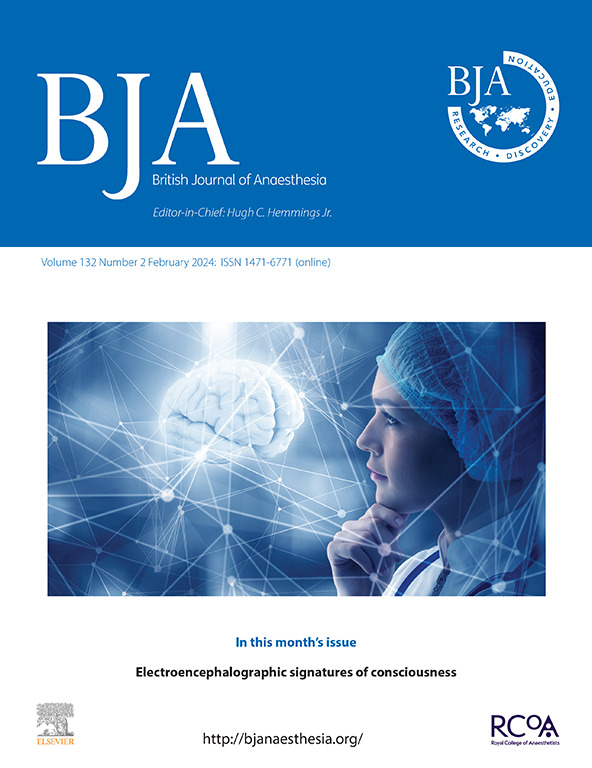阿片类药物对动物模型肿瘤生长和转移的影响:系统综述。
IF 9.1
1区 医学
Q1 ANESTHESIOLOGY
引用次数: 0
摘要
背景:国际癌症研究机构的专著最近将鸦片消费列为人类致癌物,有充分的证据表明在喉部、肺和膀胱中有致癌性,而在食道、胰腺、胃和咽部的证据有限。这引起了人们对与使用药物阿片类药物有关的同一器官中潜在的促癌作用的担忧。方法:我们对已发表的体内临床前文献进行了系统回顾(注册在开放科学框架:osf.io/xyg9p),以确定阿片类药物对肿瘤生长和转移的影响是否具有器官特异性。我们调查了阿片类药物类别(激动剂、拮抗剂或肽)、癌细胞的起源器官、肿瘤测量部位、啮齿动物的免疫状态、阿片类药物剂量或阿片类药物暴露的持续时间是否与报告的癌症结果相关。结果:共纳入118篇研究,168个实验。大多数动物实验(94/168,56%)报告了阿片类药物的抗癌作用,31(18%)报告了促癌作用。结论:我们没有发现阿片类药物具有器官特异性、促癌作用的关系。本文章由计算机程序翻译,如有差异,请以英文原文为准。
Effects of opioids on tumour growth and metastasis in animal models: a systematic review
Background
The International Agency for Cancer Research monographs recently classified opium consumption as carcinogenic to humans, with sufficient evidence for carcinogenicity in the larynx, lung, and urinary bladder and limited evidence in the oesophagus, pancreas, stomach, and pharynx. This causes concerns of a potential cancer-promoting effect in the same organs associated with the use of pharmaceutical opioids.
Methods
We performed a systematic review (registered in the Open Science Framework: osf.io/xyg9p) of the published in vivo preclinical literature to determine whether the effects of opioids on tumour growth and metastasis are organ specific. We investigated whether the opioid category (agonist, antagonist, or peptide), organ of origin of the cancer cells, site of tumour measurement, immune status of rodents, opioid dose, or duration of opioid exposure was associated with reported cancer outcomes.
Results
A total of 118 studies, representing 168 experiments, were included. Most animal experiments (94/168, 56%) reported an anti-cancer effect of opioids and 31 (18%) reported a pro-cancer effect. Of the assessed parameters, opioid category (P<0.001) and opioid dose (P=0.0056) were the only factors significantly associated with the reported cancer outcome. In studies testing morphine, experiments showing a cancer-promoting effect predominantly administered low doses of morphine (the proportion of studies using low-dose morphine was 65% among those reporting pro-cancer outcomes vs 8% among those reporting anti-cancer outcomes).
Conclusions
We found no relationship indicative of an organ-specific, cancer-promoting effect of opioids.
求助全文
通过发布文献求助,成功后即可免费获取论文全文。
去求助
来源期刊
CiteScore
13.50
自引率
7.10%
发文量
488
审稿时长
27 days
期刊介绍:
The British Journal of Anaesthesia (BJA) is a prestigious publication that covers a wide range of topics in anaesthesia, critical care medicine, pain medicine, and perioperative medicine. It aims to disseminate high-impact original research, spanning fundamental, translational, and clinical sciences, as well as clinical practice, technology, education, and training. Additionally, the journal features review articles, notable case reports, correspondence, and special articles that appeal to a broader audience.
The BJA is proudly associated with The Royal College of Anaesthetists, The College of Anaesthesiologists of Ireland, and The Hong Kong College of Anaesthesiologists. This partnership provides members of these esteemed institutions with access to not only the BJA but also its sister publication, BJA Education. It is essential to note that both journals maintain their editorial independence.
Overall, the BJA offers a diverse and comprehensive platform for anaesthetists, critical care physicians, pain specialists, and perioperative medicine practitioners to contribute and stay updated with the latest advancements in their respective fields.

 求助内容:
求助内容: 应助结果提醒方式:
应助结果提醒方式:


